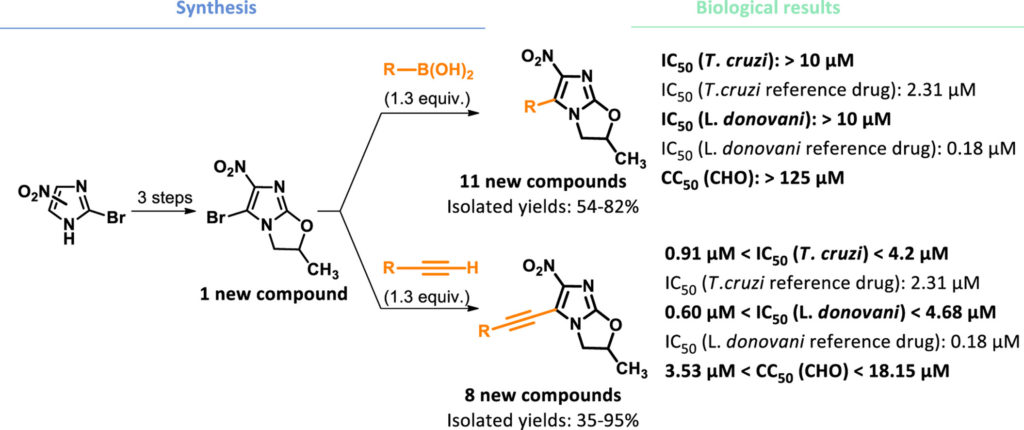Synthesis and in vitro evaluation of new 5-substituted 6-nitroimidazooxazoles as antikinetoplastid agents
 In continuation of our pharmacomodulation work on the nitroimidazooxazole series, we report the synthesis of new 5-substituted 6-nitroimidazooxazole derivatives. Our aim was to evaluate how functionalization of the 5-position of the 6-nitroimidazooxazole scaffold affects antileishmanial and antitrypanosomal in vitro activities. Twenty-one original compounds were synthesized and evaluated for their in vitro antileishmanial (L. donovani) and antitrypanosomal (T. cruzi) properties. Pallado-catalyzed cross-coupling reactions were used to introduce an aryl or ethynyl aryl substituent in 5-position from a 5-brominated-6-nitroimidazooxazole starting product. Unfortunately, the first series of compounds bearing an aryl group in 5-position presented limited in vitro activities against L. donovani and T. cruzi, with IC50 > 10 μM (vs 0.18 μM and 2.31 μM for the reference drugs amphotericin B and benznidazole respectively). Interestingly, the second series of compounds bearing an ethynyl aryl substituent in 5-position showed more promising, particularly against T. cruzi. Compounds 6a, 6b, 6c, 6g and 6h had better activity than the reference drug benznidazole (0.92 μM ≤ IC50 ≤ 2.18 μM vs IC50 = 2.31 μM), whereas the non-functionalized 2-methyl-6-nitro-2,3-dihydroimidazo [2,1-b]oxazole 2 was not active against T. cruzi (IC50 > 10 μM).
In continuation of our pharmacomodulation work on the nitroimidazooxazole series, we report the synthesis of new 5-substituted 6-nitroimidazooxazole derivatives. Our aim was to evaluate how functionalization of the 5-position of the 6-nitroimidazooxazole scaffold affects antileishmanial and antitrypanosomal in vitro activities. Twenty-one original compounds were synthesized and evaluated for their in vitro antileishmanial (L. donovani) and antitrypanosomal (T. cruzi) properties. Pallado-catalyzed cross-coupling reactions were used to introduce an aryl or ethynyl aryl substituent in 5-position from a 5-brominated-6-nitroimidazooxazole starting product. Unfortunately, the first series of compounds bearing an aryl group in 5-position presented limited in vitro activities against L. donovani and T. cruzi, with IC50 > 10 μM (vs 0.18 μM and 2.31 μM for the reference drugs amphotericin B and benznidazole respectively). Interestingly, the second series of compounds bearing an ethynyl aryl substituent in 5-position showed more promising, particularly against T. cruzi. Compounds 6a, 6b, 6c, 6g and 6h had better activity than the reference drug benznidazole (0.92 μM ≤ IC50 ≤ 2.18 μM vs IC50 = 2.31 μM), whereas the non-functionalized 2-methyl-6-nitro-2,3-dihydroimidazo [2,1-b]oxazole 2 was not active against T. cruzi (IC50 > 10 μM).
Fanny Mathias, AnitaCohen, Youssef Kabri, Núria Waddington Negrão, Maxime D.Crozet, RobertoDocampo, Nadine Azas, Patrice Vanelle. Eur J Med Chem. 2020 Feb 14;191:112146. doi: 10.1016/j.ejmech.2020.112146
